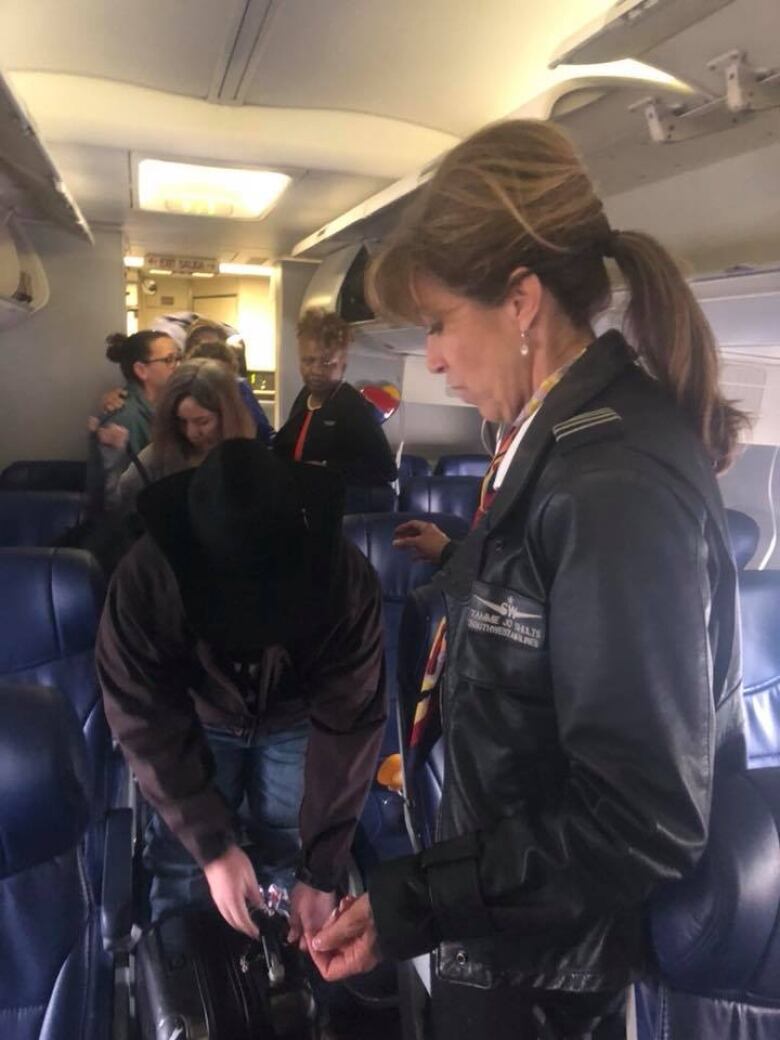U.S. regulators to require inspections after Southwest aircraft engine explosion
Investigation into fatal accident finds evidence of metal fatigue

U.S. airline regulators said late Wednesday that they will order inspections on engine fan blades like the one involved in fatal accident that killed a woman on a Southwest Airlines flight this week, forcing an emergency landing in Philadelphia.
The Federal Aviation Administration (FAA) said it will issue a directive in the next two weeks to require inspections of certain CFM56-7B engines.
The announcement came after initial findings from investigators showed that Tuesday's emergency was caused by an enginefan blade that snapped off causing debris to tear open a section of the Boeing 737's fuselage. A passenger was partially pulled out by the pressure loss and killed.
Meanwhile, global airlines beganinspecting some Boeing 737 engines on Wednesday as the U.S.investigation gathered pace. European regulators earlier this month ordered checksfollowing lengthy analysis of a similar non-fatal incident atSouthwest two years ago but investigators warn it is too earlyto say whether the two problems are linked.
Thepassenger who died aboard Southwest Flight 1380 has been identified as 43-year-old Jennifer Riordan, a Wells Fargo bank executive and mother of two from Albuquerque, N.M.

She was sitting near awindow in Row 14 when she was partially sucked out of the plane before other passengers managed to pull her back in.Philadelphia's medical examiner said Riordan died of blunt impact trauma to her head, neck and torso. Seven other passengers suffered minor injuries.
French accident investigators said on Wednesday they weresending a team to assist the investigation led by the Washington-based National Transportation Safety Board (NTSB) becausethe engine was developed by a French-U.S. joint venture, CFMInternational.
France's Safran, which co-produces the enginesalong with General Electric, will also provide technical support, a spokesman for the BEA air accident agency added.
The investigation is focusing on whether wear and tear caused one of the engine's 24 fan blades to snap off, triggering a chain of events lasting 22 minutes before thelanding.
NTSBchairman RobertSumwalttold reporters that thefan blade separated in two places, first at the engine hub, where there is evidence of a "fatigue fracture," and then halfway through the blade.
"It was on the interior part of the fan blade, so [the fracture] wasnot detectable from looking atitfrom the outside,"Sumwaltsaid. Earlier Wednesday, he said there was evidence of metal fatigue where the blade had separated.
As the left engine failed, the plane went into a "rapid left roll," the cabin lost pressure,and the aircraft began to vibrate a "fair amount" for the rest of the flight, he said.
Sumwalt said the pilots landed with fewer flaps open in order to maintain control, but that meant approaching at a greater speed. They touched down at around 165 knots (305 km/h), when a typical speed would be 134 knots (247 km/h).
Similar incident in 2016
From investigators' initial findings, the accident appears remarkably similar to a failure on another Southwest plane two years ago an event that led the engine manufacturer and regulators to push for ultrasonic inspections of fan blades on engines like the one that blew apart nearly 10,000 metres over Pennsylvania on Tuesday.
Metal fatigue is a weakening of metal from repeated use and involves microscopic cracks. It can occur in fan blades, the aluminum skin on most planes, or other metal parts.
A piece of the engine covering was later found in Bernville, Pa., about 112 kilometres west of Philadelphia.
Audio of pilot's voice released
An audio recording reveals some of what pilot Tammie Jo Shultssaid after the engine's cover blew off:
- Shults: "We have a part of the aircraft missing."
- Shults: "Could you have the medical meet us there on the runway as well? We've got injured passengers."
- Air traffic control: "Injured passengers, OK. And is your airplane physically on fire?"
- Shults: "No, it's not on fire. But part of it is missing. They said there's a hole and that someone went out."
- Air traffic control: "Um, I'm sorry. You said there was a hole and somebody went out? Southwest 1380 it doesn't matter. We will work it out there. So the airport's off to your right."
Transcribing all of the audio from the cockpit could take several days, Sumwaltsaid, because both pilots were wearing oxygen masks on the twin-engine plane, bound from New York to Dallas.Oxygen masks dropped from the ceiling and passengers said their prayers and braced for impact.

The NTSB investigation is expected to take 12 to 15 months.
"There needs to be proper inspection mechanisms in place to check for this before there's a catastrophic event," said Sumwalt, telling reporters later that the NTSB will track the history of the broken fan blade.
Examiningsimilar engines in Southwest fleet
Southwest said Tuesday night that it would inspect similar engines in its fleet over the next 30 days.
European regulators this month began requiring an inspection by early next year of the CFM56 engine, which was used on the ill-fated Southwest flight to Dallas.The actions show there has been some concern, albeit non-urgent, about the engine, a workhorse of the global civil aviation fleet that has logged more than 350 million hours of safe travel, but was also being examined after the2016 accident.

In August 2016, a Southwest flight made a safe emergency landing in Pensacola, Fla., after a fan blade separated from the same type of engine, and debris ripped a foot-long hole above the left wing. The 2016 incident prompted the U.S. Federal Aviation Administration (FAA) to propose ultrasonic inspections of similar fan blades and their replacement should they fail the test.
The FAA had "determined the unsafe condition described previously is likely to exist or develop in other products of the same type design," according to its proposal last year.

The European Aviation Safety Agency (EASA) issued an airworthiness directive last month requiring a one-time ultrasonic inspection of each affected fan blade on models of CFM56 engines within nine months of April 2. It said that CFM had sent a service bulletin recommending inspections, leading regulators to make the directive. EASA said the directive was issued after the failure of a fan blade on a CFM56 engine, which led to the uncontained release of debris.
The EASAdid not name the airline involved or the incident, but the service bulletin it referenced was the same as in the Federal Aviation Administrationproposal.
Sumwaltsaid at theNTSBbriefing thatinvestigators have not yet determined whether the engine and fan blades on Dallas-boundFlight 1380 weresubject to an FAA air worthiness directive that came from the 2016 incident.
The FAA proposal estimated 220 engines on U.S. registered planes would be affected and that checks would require two hours of labour per inspection.
Any design issues with the long-establishedCFM56engine could have repercussions for fleets worldwide. But given that thousands of the engines are already in use globally, industry experts say the focus of the investigation is more likely to fall on one-off production or maintenance issues.
Pilot had 'nerves of steel'
Passengers praised Shultsfor her cool-headed handling of the emergency. Shults, a navy veteran and one of the first female fighter pilots in the U.S. military, was at the controls when the jet landed, according to her husband, Dean Shults.
She walkedwalked down the aisle and talked with passengers to ensure they were OK after the aircraft touched down.
"She has nerves of steel. That lady, I applaud her," said Alfred Tumlinson, of Corpus Christi, Texas. "I'm going to send her a Christmas card, I'm going to tell you that, with a gift certificate for getting me on the ground. She was awesome."
Southwest CEO Gary Kelly said there were no problems with the plane or its engine when it was inspected on Sunday.
With files from Reuters and CBC News













_(720p).jpg)


 OFFICIAL HD MUSIC VIDEO.jpg)
.jpg)



























































































